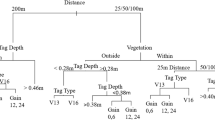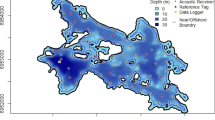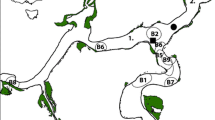Abstract
Locations of potential spawning areas for lake trout (Salvelinus namaycush) were predicted in Lake Opeongo, Ontario, Canada using information gained via acoustic telemetry and geographic information system (GIS) technologies. From 1998 to 2000, 18 adult lake trout (mean fork length 553 mm) implanted with acoustic transmitters (battery life 2 years) were manually tracked. For evening fall locations within the erosive zone of the lake (determined using an existing sedimentation model), habitat variables (slope, depth, and effective fetch) were summarised using GIS. Sites selected by lake trout during the spawning window were in areas of mean fetch equal to 1.5 km and mean slope of 10.6% (n = 50 fixes). We used GIS to identify areas that matched the mean habitat criteria and thus locate potential spawning areas. This model correctly identified 19 of 21 known spawning sites, as well as additional sites used by spawning females in an earlier telemetry study. Depths of traditional fall netting sites are shallow compared to areas in which telemetered lake trout were found during evenings of the spawning period (means 3.1 vs. 5.1 m, respectively). Through the use of information on spawning habitat selection gained through telemetry and knowledge of the physical characteristics of the lake, we provide an alternative means of identifying potential spawning habitat for lake trout.
Similar content being viewed by others
References
Blundell, G. M., J. A. K. Maier & E. M. Debevec, 2001. Linear home ranges: effects of smoothing, sample size, and autocorrelation on kernel estimates. Ecol. Monogr. 71: 469-489.
DeRoche, S. E., 1969. Observations on the spawning habits and early life of lake trout. Prog. Fish-Cult. 31: 109-113.
Fitzsimmons, J. D., 1994. An evaluation of lake trout spawning habitat characteristics and methods for their detection. Can. Tech. Rep. Fish. aquat. Sci. No.1962: 1-26.
Fitzsimmons, J. D., 1995. Assessment of lake trout spawning habitat and egg deposition and survival in Lake Ontario. J. Great Lakes Res. 21: 337-347.
Fitzsimmons, J. D., 1996. The significance of man-made structures for lake trout spawning in the Great Lakes: are they a viable alternative to natural reefs? Can. J. Fish. aquat. Sci. 53: 142-151.
Fitzsimmons, J. D. & T. B. Williston, 2000. Evidence of lake trout spawning in Lake Erie. J. Great Lakes Res. 26: 489-494.
Gross, M. R., 1984. Sunfish, salmon, and the evolution of alternative reproductive strategies and tactics in fishes. In Potts, G. W. & R. J. Wootton (eds), Fish Reproduction: Strategies and Tactics. Academic Press Inc., London: 55-76.
Gunn, J. M., 1995. Spawning behaviour of lake trout: effects on colonization ability. J. Great Lakes Res. 21: 323-329.
Gunn, J. M., M. Conlon, R. J. Kirk & S. C. McAughey, 1996. Can trained observers accurately identify lake trout spawning habitat? Can. J. Fish. aquat. Sci. 53: 327-331.
Liimatainen, V. A., E. J. Snucins & J. M. Gunn, 1987. Observations of lake trout (Salvelinus namaycush) spawning behaviour in low pH lakes near Sudbury, Ontario. Ontario Fisheries Acidification Report Series No. 87-10: 1-71.
MacLean, J. A., D. O. Evans, N. V. Martin & R. L. DesJardine, 1981. Survival, growth, spawning distribution, and movements of introduced and native lake trout (Salvelinus namaycush) in two inland Ontario lakes. Can. J. Fish. aquat. Sci. 38: 1685-1700.
MacLean, N. G., J. M. Gunn, F. J. Hicks, P. E. Ihssen, M. Malhiot, T. E. Mosindy & W. Wilson, 1990. Environmental and genetic factors affecting the physiology and ecology of lake trout. In: Physiology and Ecology Working Group, Lake Trout Synthesis. Ontario Ministry of Natural Resources, Toronto, Ontario: 1-84.
Marsden, J. E., D. L. Perkins & C. C. Krueger, 1995. Recognition of spawning areas by lake trout: deposition and survival of eggs on small, man-made rock piles. J. Great Lakes Res. 21: 330-336.
Martin, N. V., 1955. The effect of drawdowns on lake trout reproduction and the use of artificial spawning beds. Trans. N. am. Wildl. Conf. 20: 263-271.
Martin, N. V., 1957. Reproduction of lake trout in Algonquin Park, Ontario. Trans. am. Fish. Soc. 86: 231-244.
Martin, N. V. & C. H. Olver, 1980. The lake charr, Salvelinus namaycush. In Balon, E. K. (ed.), Charrs: Salmonid Fishes of the Genus Salvelinus. Dr W. Junk Publishers, The Hague, Netherlands: 205-277.
McAughey, S. C. & J. M. Gunn, 1995. The behavioral response of lake trout to a loss of traditional spawning sites. J. Great Lakes Res. 21 (Suppl. 1): 375-383.
McCrimmon, H. R., 1958. Observations on the spawning of lake trout, Salvelinus namaycush, and the post-spawning movement of adult trout in Lake Simcoe. Can. Fish Cult. 23: 3-11.
Rowan, D. J., J. Kalff & J. B. Rasmussen, 1992. Estimating the mud deposition boundary depth in lakes from wave theory. Can. J. Fish. aquat. Sci. 49: 2490-2497.
Schoener, T. W., 1981. An empirically based estimate of home range. Theor. Pop. Biol. 20: 281-325.
Schreiner, D. R., C. R. Bronte, N. R. Payne, J. D. Fitzsimons & J. M. Casselman, 1995. Use of egg traps to investigate lake trout spawning in the Great Lakes. J. Great Lakes Res. 21: 433-444.
Sly, P. G., 1988. Interstitial water quality of lake trout spawning habitat. J. Great Lakes Res. 14: 301-315.
Sly, P. G. & D. O. Evans, 1996. Suitability of habitat for spawning lake trout. J. Aquat. Ecosyst. Health 5: 153-175.
Swihart, R. K. & N. A. Slade, 1985. Testing for independence of observations in animal movements. Ecology 66: 1176-1184.
Wagner, G. N. & E. D. Stevens, 2000. Effects of different surgical techniques: suture material and location of incision site on the behaviour of rainbow trout (Oncorhynchus mykiss). Mar. Fresh. Behav. Physiol. 33: 103-114.
Author information
Authors and Affiliations
Rights and permissions
About this article
Cite this article
Flavelle, L., Ridgway, M., Middel, T. et al. Integration of acoustic telemetry and GIS to identify potential spawning areas for lake trout (Salvelinus namaycush). Hydrobiologia 483, 137–146 (2002). https://doi.org/10.1023/A:1021371327810
Issue Date:
DOI: https://doi.org/10.1023/A:1021371327810




